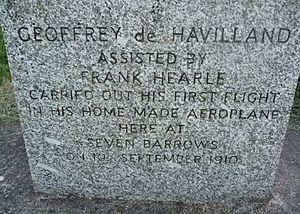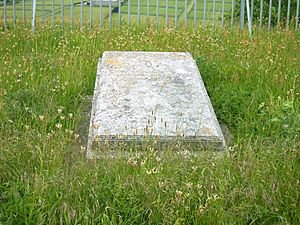Beacon Hill, Burghclere, Hampshire facts for kids
- There are two hills in Hampshire called Beacon Hill; the other one is near Warnford.
| Site of Special Scientific Interest | |
| Area of Search | Hampshire |
|---|---|
| Interest | Biological |
| Area | 80.7 hectares (199 acres) |
| Notification | 1984 |
| Location map | Magic Map |
| Beacon Hill | |
|---|---|
| Highest point | |
| Elevation | 261 m (856 ft) |
| Geography | |
| Location | Hampshire, England |
| OS grid | SU458573 |
| Topo map | OS Landranger 174 |
Beacon Hill is a famous hill in north Hampshire, England. It is close to the village of Burghclere and Watership Down. The hill is named "Beacon Hill" because it used to have a special fire, or 'beacon', on top. This beacon was once the most famous one in Hampshire.
The hill is 261 metres (about 856 feet) high. It has one of England's most well-known hill forts on its slopes. You can see this ancient fort from the main A34 road nearby. From the top, you get amazing views of the area and much of Hampshire. Beacon Hill is open to everyone and is looked after by Hampshire County Council. It is also a special nature area called Burghclere Beacon. This area is important for its rare plants and animals.
Nature and Wildlife
Beacon Hill is a special type of natural area called a calcareous grassland. This means it's a chalky hillside with lots of grass. These areas are quite rare and are home to unusual and uncommon plants and animals.
If you look closely at the slopes of Beacon Hill, you might see a stepped pattern. This was made over hundreds of years by sheep grazing. Their constant walking and eating created these visible steps on the hillside.
The hill has many different kinds of plants. There are bushes like juniper, privet, buckthorn, and hawthorn. These cover a large part of the western slopes. Over time, these bushes might grow into a mixed woodland.
The open grassy areas are full of interesting wildflowers. You can find fescue grasses, crested dog's tail, and spring sedge. Other common flowers include ladys’ bedstraw, hedge bedstraw, fairy flax, and bird's-foot trefoil. You might also spot horseshoe vetch, kidney vetch, and several types of orchids. These flowers attract rare insects, like the Osmia bicolor bee.
Ancient History
The hill fort at the top of Beacon Hill is very old and well-preserved. It was built around 1000 BC, which is about 3,000 years ago! Experts believe that between 2,000 and 3,000 people might have lived here. This fort is one of many ancient forts found along the northern edge of the Hampshire Downs. These forts would have looked amazing when they were first built, with their white chalk walls shining in the sun.
Inside the fort, you can still see the remains of about fifteen ancient hut sites. These are circular or horseshoe-shaped hollows where people's homes once stood. The main entrance to the fort, facing south, is still clear. A path would have led from here to ancient fields, which you can still see traces of today. Aerial photos show many old field patterns in the surrounding countryside.
Near Beacon Hill, there are also ancient burial mounds. North of the hill, there is a Bronze Age Bowl Barrow (an old burial mound) hidden in a fir tree plantation. About 150 yards south of the hill fort, there is another Bronze Age round Barrow.
On the north slope of the hill, you can see two "lynchets." These are terraces formed by ancient farming. There are also some "hollow-ways," which are old sunken paths.
The beacon fire on this hill was part of a warning system. It would pass on signals from Hampshire to Cuckhamsiey Beacon in Berkshire. When archaeologists dug nearby, they found old fireplaces, pottery, and tobacco pipes. This suggests there was a small shelter for the people who watched over the bonfire.
The tomb of a famous Egyptologist, George Herbert, 5th Earl of Carnarvon, is located within the old fort. He was known for helping to discover the tomb of Tutankhamun in Egypt. Also, a memorial stone marks the spot where Sir Geoffrey de Havilland made his first successful test flight in an airplane on September 10, 1910. This stone is in the Seven Barrows field, south of Beacon Hill.
Location Details
Beacon Hill is located southwest of the village of Old Burghclere in Hampshire. Its highest point is 261 metres above sea level. To the east, you'll find Ladle Hill and further east is Watership Down. The A34 runs between Beacon Hill and Ladle Hill. To the west is Sidown Hill.
Images for kids



